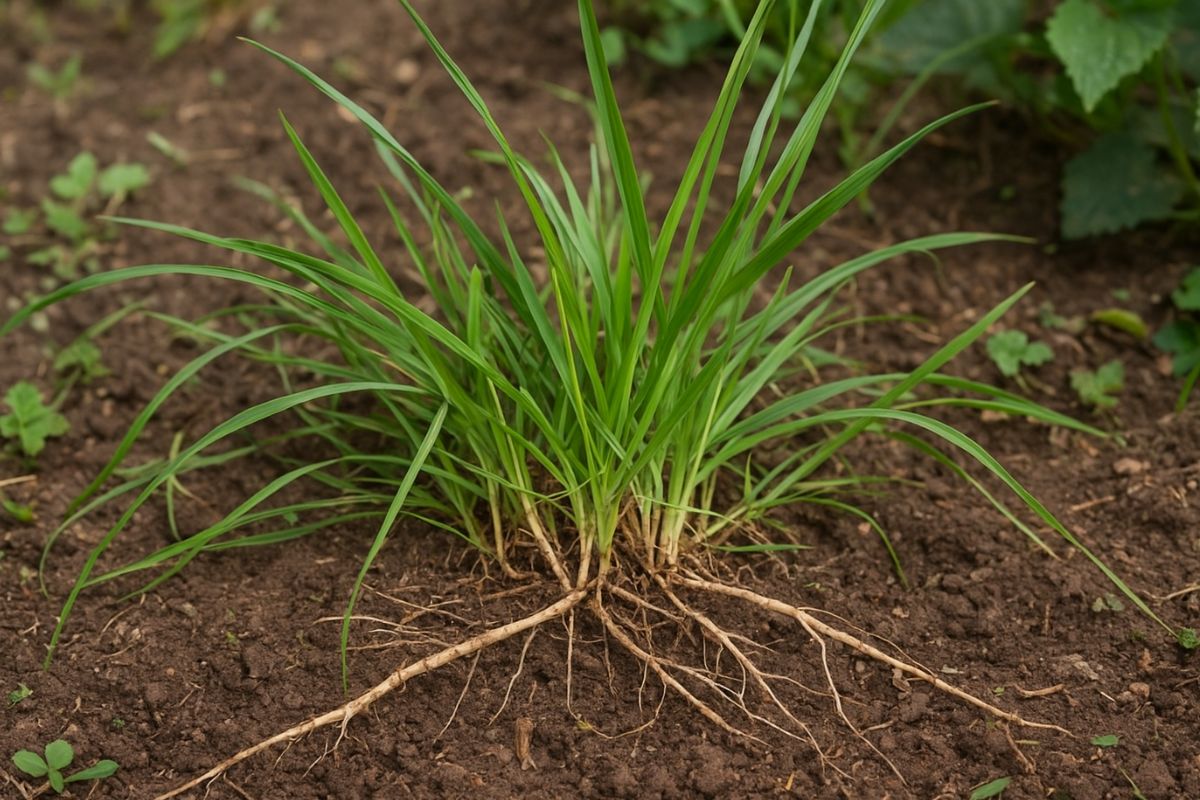Couch grass. That complete nightmare that invades gardens more quickly than bindweed at a party. You pull it up, and it comes back stronger. You dig it out, and it laughs at you. You curse at it, well, that definitely doesn’t work.
So, how to get rid of couch grass plant properly? Take a seat, because there are no easy answers. Just hard work and a lot of patience.
Why This Couch Grass Is So Annoying
Couch grass (or Elymus repens if we are being posh) spreads by means of white underground stems known as rhizomes. These things are sneaky. They flourish beneath your beautiful plants, wind themselves around roots, and generally squat rent-free in your garden.
Every spring and autumn, there is a sprout of new shoots that, in no time at all, makes tufts of leaves and even more rhizomes. So you’re attacking what you can see, but there’s a huge network growing underneath. Clever, really. Annoying, but clever.
Here’s the worst bit. Whatever tiny bit of rhizome is left behind can grow into a new plant. If you leave a piece the size of your fingernail in the ground, you’ll have couch grass again in three weeks. It feels like a never-ending horror film.
How To Get Rid Of Couch Grass Plant Naturally
Right, let’s start with the chemical-free approach because most people prefer trying that first.
Getting Your Hands Dirty
If the couch grass hasn’t gone completely mental and spread its roots everywhere, you’ll be able to dig it out by hand. Get yourself a proper hand fork, not those cheap plastic things that snap if you look at them wrong.
You just want to go at least 15–20 centimetres deep. Look for those white rhizomes. They’re like pale underground stems; some are thick and some are thin. Every single one of them has to be taken out. Miss one and you’re back here digging it all out in two weeks.
This works well for small patches. Do you have couch grass all over your border? And you’ve got weeks of digging ahead. Maybe months. Your back will hate you. Your knees will hate you. But it does work if you stick with it.
The Complete Reset Method
Sometimes the infestation is such that there’s no alternative. So you need to dig up every single plant, carefully remove all the couch grass from their roots (I say it like that as if it’s a breeze), and pot them up or stick them somewhere temporary. Then dig over the entire bed and pull out every rhizome.
Sounds bonkers, doesn’t it? Loads of work for one pest. But there is no alternative sometimes. Keep the bed vacant for a few weeks. Any couch grass you’ve missed will make itself known. Pull that out, too. Wait again. Continue until nothing else comes up.
Only replant when you’re certain it’s gone. Yes, it’s exhausting. Yes, you’ll question your life choices. But it actually works.
How To Get Rid Of Couch Grass On Allotment
Allotments are generally full of the stuff, as it spreads between plots like gossip at a village fête. Your neighbour’s couch grass problem becomes yours faster than you can brew a cup of tea.
Here’s something interesting. Sow turnip seed in the affected bed. You see, as luck would have it, couch grass and turnips don’t appear to be friends, so the grass wilts back and dies off. Worth trying, isn’t it? And even if it only half works, you will still get turnips!
Some allotment holders cover problem areas with thick black plastic or old carpet for an entire growing season. Starves the grass of light. Takes forever but eventually works. Just accept that section’s a write-off for the year.
ALSO READ: Why Sarah Harding Partner Made Headlines and Broke Hearts
How To Get Rid Of Couch Grass In Borders Using Chemicals
Sometimes, grasskiller is your only practical choice. Not what lovers of organic gardens want to hear, but we need to be realistic.
Apply a systemic grasskiller that contains glyphosate, such as Roundup Ultra. Best done in the spring when everything is growing actively. The grasskiller gets absorbed through the leaves and travels down to kill the roots and rhizomes.
Critical thing, though. Glyphosate kills everything it touches. Do make sure the rest of your plants are well covered with plastic sheeting. Get some on your roses? Dead. Splashes on your hostas? Gone. It doesn’t care what it takes down with it.
You will most likely need to apply a spray every six weeks until all the couch grass is treated. Might take three applications. Might take eight. Depends on how bad things are.
How To Get Rid Of Couch Grass In Lawn
Bad news time. There are no selective grasskillers that kill couch grass but leave your other grass alone. So your options are all rubbish.
Does Regular Mowing Kill Couch Grass?
Nope. Couch grass actually quite likes being mowed. It just grows back lower and denser, like it’s training to be a ground cover plant. You can cut a fresh edge to your lawn using an edging iron and turn over the adjacent border soil with a fork to stop it spreading, but that won’t kill what’s already there.
The only real solution for lawns is starting over. Strip off the turf. Dig out every rhizome you can find. Re-turf or re-seed the whole thing. Massive pain, but it works.
Or spray the entire lawn with glyphosate, wait for everything to die (it’ll look awful; prepare yourself), then start fresh. Not ideal if you actually wanted to use your lawn this summer, but sometimes you’ve got no choice.
Does Vinegar Kill Couch Grass?
People ask this all the time. The answer is sort of, but not really.
Vinegar burns the leaves and kills what’s above ground. Looks effective for about five minutes. But it doesn’t reach down to the rhizomes. The couch grass just regrows from below like nothing happened. You’d need industrial-strength vinegar applied constantly to make any difference. Honestly, save your vinegar for chips.
How To Get Rid Of Couch Grass Plant In Winter
Winter’s actually not a bad time to tackle this if you don’t mind frozen fingers. The grass is dormant, so it’s not actively spreading. Your other plants are mostly sleeping too, making it easier to work around them without damaging anything.
How to get rid of couch grass naturally in winter means the same digging approach, but with numb hands. Get your fork, dig deep, and pull out every rhizome. The cold won’t kill couch grass because it’s as tough as old boots, but it does slow everything down.
Cover problem areas with thick black plastic or cardboard weighted down with bricks or stones. Leave it there all winter. Come spring, check underneath. You’ll probably still find some couch grass, but you’ll have made progress at least.
Stop It Coming Back
Always check the rootballs of plants before you put them in the ground. Remove any couch grass rhizomes hiding in there. That’s how most people get infested in the first place. Someone gives you a plant division, you stick it straight in, and six months later, you’ve got couch grass everywhere.
Also, watch what topsoil or compost you bring in. Could be full of rhizome fragments. Buy from places that actually screen their stuff properly, not just whoever’s cheapest.
What Nobody Tells You About Couch Grass
How to get rid of couch grass plant isn’t something you do once and tick off the list. It’s a proper campaign. You’ll think you’ve won. Feel all proud of yourself. Then three weeks later you’ll spot new shoots and realise the war’s still on.
Some gardeners eventually just give up and accept it. The RHS even says couch grass makes an attractive and wildlife-friendly addition to species-rich lawns and meadows. That’s one way to look at defeat, I suppose. Most of us would rather it went and bothered someone else’s meadow, though.
The real key is just not giving up. Keep digging. Keep pulling. Keep checking. Eventually, you’ll win. Might take a whole year. Might take two. But if you’re stubborn enough, you’ll beat it.
And when you finally do? You’ll feel like you’ve won gold at Chelsea. Because honestly, getting rid of couch grass is harder than growing perfect dahlias or training clematis or any of that other stuff people think is difficult. This is the real test of a gardener.








